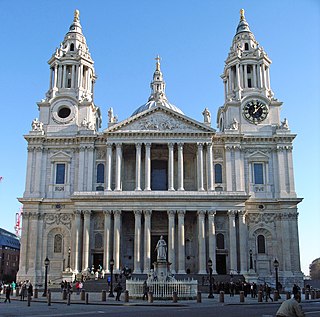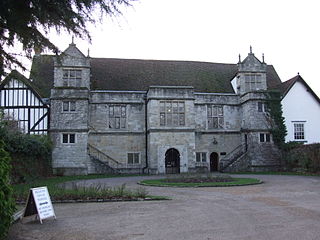
Baron Hastings is a title that has been created three times. The first creation was in the Peerage of England in 1290, and is extant. The second creation was in the Peerage of England in 1299, and became extinct on the death of the first holder in c. 1314. The third creation was in the Peerage of England in 1461, and has been in abeyance since 1960.

Seaton Delaval Hall is a Grade I listed country house in Northumberland, England, near the coast just north of Newcastle upon Tyne. Located between Seaton Sluice and Seaton Delaval, it was designed by Sir John Vanbrugh in 1718 for Admiral George Delaval; it is now owned by the National Trust.

Seaton Delaval is a village and former civil parish, now in the parish of Seaton Valley, in Northumberland, England, with a population of 4,371. The largest of the five villages in Seaton Valley, it is the site of Seaton Delaval Hall, completed by Sir John Vanbrugh in 1727.

Hugh May was an English architect in the period after the Restoration of King Charles II. He worked in the era which fell between the first introduction of Palladianism into England by Inigo Jones, and the full flowering of English Baroque under John Vanbrugh and Nicholas Hawksmoor. His own work was influenced by both Jones' work, and by Dutch architecture. Although May's only surviving works are Eltham Lodge, and the east front, stables and chapel at Cornbury House, his designs were influential. Together with his contemporary, Sir Roger Pratt, May was responsible for introducing and popularising an Anglo-Dutch type of house, which was widely imitated.

Delaval is the surname of a family of gentry/aristocracy in Northumberland, England, from the 11th century to the 19th century. Their main estate was the manor of Seaton Delaval. The 18th century Delavals are noteworthy for their colourful lifestyle, for the magnificent Seaton Delaval Hall and for the development of the little seaport of Seaton Sluice and a coal mine at Old Hartley.

Seaton Sluice is a village in Northumberland. It lies on the coast at the mouth of the Seaton Burn, midway between Whitley Bay and Blyth. In the 2021 census the village had a population of 2,956.

Doddington Hall is, from the outside, an Elizabethan prodigy house or mansion complete with walled courtyards and a gabled gatehouse. Inside it was largely updated in the 1760s. It is located in the village of Doddington, to the west of the city of Lincoln in Lincolnshire, England.

English Baroque is a term used to refer to modes of English architecture that paralleled Baroque architecture in continental Europe between the Great Fire of London (1666) and roughly 1720, when the flamboyant and dramatic qualities of Baroque art were abandoned in favour of the more chaste, rule-based Neo-classical forms espoused by the proponents of Palladianism.

Sir Jacob Astley, 1st Baronet of Melton Constable Hall, Norfolk was an English Tory politician and baronet.

John Hussey Delaval, 1st Baron Delaval, known as Sir John Delaval, Bt, between 1761 and 1783, was an English landowner and politician.
Edward Delaval Henry Astley, 22nd Baron Hastings, 12th Baronet Astley was an English peer and government minister. He had many interests, including politics, ballet, charity work, Italy, and renovating Seaton Delaval Hall.

Dissington Hall is an English country house situated on the banks of the River Pont at North Dissington, Ponteland, Northumberland, England. It is a Grade II* listed building. The manor of North Dissington was for centuries the seat of the Delaval family. An earlier house on the site was the birthplace of Admiral Ralph Delaval (c.1641–c.1707) and of Admiral George Delaval who built Seaton Delaval Hall.
Edward Hussey Delaval was a British scholar and natural philosopher.

Sir Edward Astley, 4th Baronet was a British politician who sat in the House of Commons from 1768 to 1790.

The Archbishop's Palace is a Grade I listed historic 14th-century and 16th-century building on the east bank of the River Medway in Maidstone, Kent. Originally a home from home for travelling archbishops from Canterbury, the building has been most recently used as a venue for wedding services. The former tithe barn for the palace, now serves as the Tyrwhitt-Drake Museum of Carriages.
Captain Francis Blake Delaval was a Royal Navy officer and Member of Parliament.

Rhoda Delaval Astley was an English aristocrat and artist. She was married to Edward Astley, with whom she had a daughter and three sons. Lady Astley studied painting with Arthur Pond, who painted her portrait. Seaton Delaval Hall passed from the Delaval family to the Astley family through her descendants.

George Manners Astley, 20th Baron Hastings, 10th Baronet Astley succeeded to the Hastings barony upon the death of his unmarried brother in 1875.

Lieutenant-colonel Sir Jacob Henry Astley, 5th Baronet was an English landowner and Member of Parliament.

The Astley Baronetcy, of Hillmorton in the County of Warwick, was created in the Baronetage of England on 25 June 1660 for Jacob Astley, nephew of the first Baronet of Melton Constable. For more information on this creation, see Baron Hastings.



















